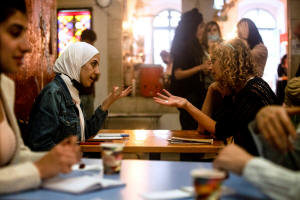|
About 20 students meet weekly at a 19th-century villa, and
sitting together, Jew facing Arab, they practise each other's
language, guided by cards spelling out simple scenarios that
prompt dialogue.
When a whistle sounds every 20 minutes, participants rotate with
new partners across tables arranged under colourful murals.
The encounters - quick and cordial, if sometimes awkward - help
the Palestinians to improve the Hebrew required for dealing with
Israeli authorities, and the Jews to deepen their grasp of
Arabic.
Most Palestinians in Jerusalem live in its eastern sector,
captured by Israel in the 1967 Middle East war. Only basic
Hebrew is studied in East Jerusalem schools, making it difficult
for Palestinians to achieve advanced proficiency.
"And it's the same for Israelis - if they do study Arabic, it's
an Arabic you can't use," said Maya Giz, a Hebrew teacher,
referring to the classical, and not commonly spoken, version of
the language.
Giz, who initiated the project in 2019 with Sahar Mukhemar, a
Palestinian sports instructor and a former student of hers, says
the language exercises are a "crossing of a mental border"
between the two peoples.
She said Palestinians and Israelis taking part in the programme
share "the same embarrassment of talking and ... (can) break
this barrier of fear together".
Jamila Khouri, a Palestinian, said learning Hebrew could help
her and others "merge well in the community and find a job
opportunity in a good field".
Jewish participant Eli Benita said the language learning spoke
volumes about coexistence, in a city where tensions in the
Israeli-Palestinian conflict sometimes spill over into violence.
"I see that this is the only way to reach some kind of a
peaceful routine of life here in this region we live in," he
said.
(Editing by Jeffrey Heller and Ed Osmond)
[© 2021 Thomson Reuters. All rights
reserved.] Copyright 2021 Reuters. All rights reserved. This material may not be published,
broadcast, rewritten or redistributed.
Thompson Reuters is solely responsible for this content.

|
|




